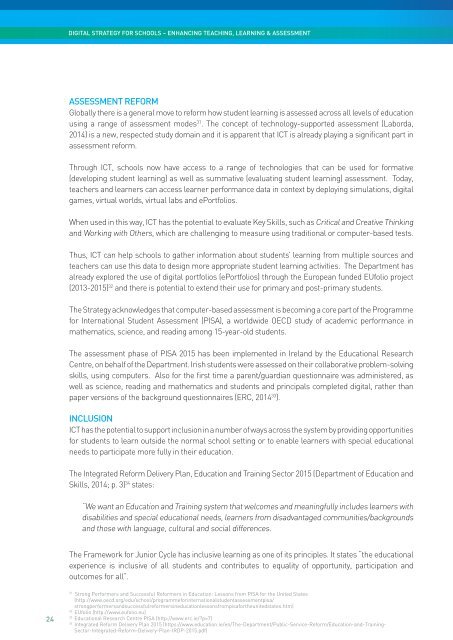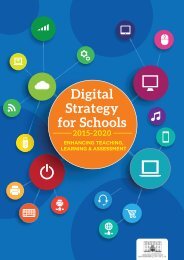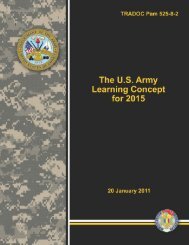Digital Strategy for Schools
TKmef
TKmef
You also want an ePaper? Increase the reach of your titles
YUMPU automatically turns print PDFs into web optimized ePapers that Google loves.
DIGITAL STRATEGY FOR SCHOOLS – ENHANCING TEACHING, LEARNING & ASSESSMENT<br />
ASSESSMENT REFORM<br />
Globally there is a general move to re<strong>for</strong>m how student learning is assessed across all levels of education<br />
using a range of assessment modes 31 . The concept of technology-supported assessment (Laborda,<br />
2014) is a new, respected study domain and it is apparent that ICT is already playing a significant part in<br />
assessment re<strong>for</strong>m.<br />
Through ICT, schools now have access to a range of technologies that can be used <strong>for</strong> <strong>for</strong>mative<br />
(developing student learning) as well as summative (evaluating student learning) assessment. Today,<br />
teachers and learners can access learner per<strong>for</strong>mance data in context by deploying simulations, digital<br />
games, virtual worlds, virtual labs and ePortfolios.<br />
When used in this way, ICT has the potential to evaluate Key Skills, such as Critical and Creative Thinking<br />
and Working with Others, which are challenging to measure using traditional or computer-based tests.<br />
Thus, ICT can help schools to gather in<strong>for</strong>mation about students’ learning from multiple sources and<br />
teachers can use this data to design more appropriate student learning activities. The Department has<br />
already explored the use of digital portfolios (ePortfolios) through the European funded EUfolio project<br />
(2013-2015) 32 and there is potential to extend their use <strong>for</strong> primary and post-primary students.<br />
The <strong>Strategy</strong> acknowledges that computer-based assessment is becoming a core part of the Programme<br />
<strong>for</strong> International Student Assessment (PISA), a worldwide OECD study of academic per<strong>for</strong>mance in<br />
mathematics, science, and reading among 15-year-old students.<br />
The assessment phase of PISA 2015 has been implemented in Ireland by the Educational Research<br />
Centre, on behalf of the Department. Irish students were assessed on their collaborative problem-solving<br />
skills, using computers. Also <strong>for</strong> the first time a parent/guardian questionnaire was administered, as<br />
well as science, reading and mathematics and students and principals completed digital, rather than<br />
paper versions of the background questionnaires (ERC, 2014 33 ).<br />
INCLUSION<br />
ICT has the potential to support inclusion in a number of ways across the system by providing opportunities<br />
<strong>for</strong> students to learn outside the normal school setting or to enable learners with special educational<br />
needs to participate more fully in their education.<br />
The Integrated Re<strong>for</strong>m Delivery Plan, Education and Training Sector 2015 (Department of Education and<br />
Skills, 2014; p. 3) 34 states:<br />
“We want an Education and Training system that welcomes and meaningfully includes learners with<br />
disabilities and special educational needs, learners from disadvantaged communities/backgrounds<br />
and those with language, cultural and social differences.<br />
The Framework <strong>for</strong> Junior Cycle has inclusive learning as one of its principles. It states “the educational<br />
experience is inclusive of all students and contributes to equality of opportunity, participation and<br />
outcomes <strong>for</strong> all”.<br />
24<br />
31<br />
Strong Per<strong>for</strong>mers and Successful Re<strong>for</strong>mers in Education: Lessons from PISA <strong>for</strong> the United States<br />
(http://www.oecd.org/edu/school/programme<strong>for</strong>internationalstudentassessmentpisa/<br />
strongper<strong>for</strong>mersandsuccessfulre<strong>for</strong>mersineducationlessonsfrompisa<strong>for</strong>theunitedstates.htm)<br />
32<br />
EUfolio (http://www.eufolio.eu)<br />
33<br />
Educational Research Centre PISA (http://www.erc.ie/?p=7)<br />
34<br />
Integrated Re<strong>for</strong>m Delivery Plan 2015 (https://www.education.ie/en/The-Department/Public-Service-Re<strong>for</strong>m/Education-and-Training-<br />
Sector-Integrated-Re<strong>for</strong>m-Delivery-Plan-IRDP-2015.pdf)




